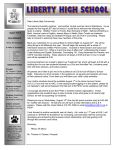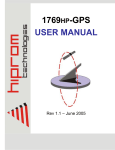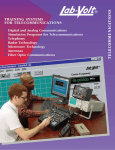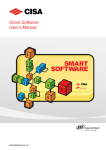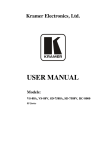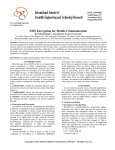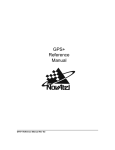Download GPS Jamming in A Laboratory Environment
Transcript
GPS Jamming in A Laboratory Environment Gregory D. Rash Naval Air Warfare Center Weapons Division (NAWCWPNS)/China Lake BIOGRAPHY Greg Rash received his Bachelor of Science in Electrical Engineering from Fresno State University in 1991. Employed by the Naval Air Warfare Center Weapons Division (NAWCWPNS), China Lake, California, he has worked on the development of phased-array antennas and has performed simulation, analysis, modeling, and testing for various missile programs. His first exposure to the Global Positioning System (GPS) occurred when he was tasked as the GPS system engineer for Tomahawk Cruise Missile in mid 1993. In late 1995 he started developing a remotely controllable GPS jamming system for laboratory use. Greg is currently part of the design team tasked with integrating an EGI for use in a real-time simulation application at the NAWCWPNS Navigation Laboratory. ABSTRACT Most modern weapon systems and aircraft depend, in part, on the Global Positioning System (GPS) for navigation. This reliance on GPS navigation dictates that laboratory test facilities be equipped to create realistic GPS jamming environments able to verify compliance with jamming specifications. Engineers at the Naval Air Warfare Center Weapons Division (NAWCWPNS) have designed and built a GPS jamming system for laboratory use to test GPS system jamming performance. This paper identifies and discusses issues related to implementing a GPS jamming system in a laboratory test environment. These issues pertain to jamming accuracy requirements, as well as important jamming system design parameters and how they may affect jamming system performance. An example of the Navigation Laboratory jamming system is presented. It addresses fabrication issues, data requirements, error handling, local and remote operations, and how to attain high accuracy and repeatability during the generation and measurement of jamming. INTRODUCTION The Global Positioning System (GPS) has effectively been operational since the early nineties and has been available to users for over a decade. In recent years, jamming of GPS has arisen as a major concern for users. Safety concerns for civilian applications, and operational concerns for the military continue to escalate. However, the vulnerability of the GPS downlink to jamming is not a new issue and has existed since the system's inception. In fact, papers discussing vulnerability date back over twenty years.1 GPS receiver testing and performance characterization against jamming has been performed by many entities, both civilian and military. No standard test methodology exists to define how accurate or repeatable GPS jamming testing should be. Only recently has there been an attempt to standardize the military’s navigation testing facilities and testing procedures.2 As a result, current navigation system testing, including GPS jamming, has not necessarily been consistent across the civilian and military communities. The intent of this paper is to define reasonable values for jammer-to-signal ratio (J/S) accuracy tolerances, and to show how errors in measuring the amplitude of GPS jamming relate to the overall accuracy of the test environment. Important jamming system parameters and design issues will then be discussed. An example will be given that describes a suite of instruments and associated techniques that perform jamming of the GPS signals while maintaining high quality control over the jamming parameters. Approved for public release; distribution is unlimited. DEFINITIONS Most jamming techniques fall into three major types usually based on bandwidth. Continuous wave, or CW jamming, is usually defined as occupying less than 100 kHz of bandwidth. In this paper, CW jamming will be defined as one frequency only. Narrowband (NB) jamming will be defined as any unwanted signal occupying more than one MHz of bandwidth but less than or equal to the entire ±1.023 MHz bandwidth of C/A code. NB is usually centered about L1 or L2 but not necessarily so. Wideband (WB) jamming will be defined as jamming signals occupying the entire ±10.23 MHz bandwidth about L1 or L2. All discussions of J/S will be related to dBm. J/S ratios are with respect to L1 or L2 P(Y) code only, where L1 = -133 dBm, L2 = -136 dBm. Three dB are added for C/A-code J/S comparisons. where JM = Measured jammer power JT = True jammer power then JT = 1.26 JM or a positive 26% error in measurement. For a -1.0 dB error in measuring jamming amplitude, we have -1 dB = 10 Log JM / JT or JT = 0.79 JM which corresponds to a negative 21% error in our measurement. Another example relating measurement error to range follows. Suppose we wish to determine the range at which a given receiver loses lock for a fixed jammer power. Since power decreases as the reciprocal of the distance from the emitter, we have JAMMING DESIGN ISSUES JM / JT = (RT /RM) Accuracy When testing GPS receivers/navigation systems, the most important jamming specification is the amplitude accuracy, because overall J/S is calculated using jamming signal amplitude. When measuring the GPS jamming signals, it is also important to note that the complete 20.46 MHz of signal bandwidth for L1 or L2 P(Y) code should be measured to ensure that all the jamming energy is accounted for when performing the J/S calculations. GPS simulator signals must also have correct signal power levels. Adjusting the power output to correct for the testing system's losses or gains usually attains this. Incorrect GPS simulator output levels will cause J/S to be artificially high or low, nullifying test results, even if the GPS jamming levels are correct. In order to validate the performance of the GPS component of any given platform in the Navigation Laboratory, we need to be able to determine J/S as accurately as possible. Any error in determining this parameter can have a large impact on system performance. For example, suppose we wish to determine how a +1.0 dB error in measuring the amplitude of jamming would affect the overall accuracy of our J/S calculation. Assume there is no amplitude error in S, the GPS signal level, and that it is a constant value. Given 1 dB = 10 Log JM / JT 2 where RT = range calculated using JT RM = range calculated using JM This equation can be rewritten as 10 Log JM – 10 Log JT = 20 Log RT /RM If we assume a +1.0 dB error in measuring JM, we have -1/20 RM = RT * 10 or RM = 0.89 RT This represents an 11% error in our range estimate to jamout, possibly a critical parameter of the system's operational design. This error may translate into an operational concern for certain customers. Based upon these brief calculations, it appears that the maximum amplitude measurement error we should allow for when performing GPS jamming is ±1.0 dB. For reference, the Interstate Electronics Corporation (IEC)3 GPS constellation simulator specifies an amplitude accuracy of ±0.7 dB root sum squared when generating satellite signals, on par with the previously stated accuracy requirement for jamming signals. The total amplitude error of J/S that exists when performing jamming testing will be made up of errors in both J and S. Amplitude errors in the simulator output S cannot be easily calibrated and reflect the performance specification of the GPS simulator. Amplitude errors in jamming or J can be minimized but not completely eliminated. To produce GPS jamming signals that have accuracy values similar to the simulator means generating jamming signals with less than ±0.7 dB of amplitude error. GPS receiver/system testing can be performed with or without the antenna or antenna subsystem. When testing with single-element or multi-element antennas, the requirement that all jamming be measured to within ±1.0 dB is still valid. If jamming an actual antenna system in an anechoic chamber, a calibrated radio frequency (RF) horn or some other measurement device should be used to determine the actual power levels present at the antenna elements. When testing GPS receivers without the antenna, the signal specification for power at the input to the receiver must be accounted for. This signal level can be above or below ICD-GPS-200 levels. All system gains or losses must be accounted for to ensure the signal feeding the input to the receiver under test is correct in amplitude. If jamming a multi-element GPS receiver system without the antenna, then each RF input (one per antenna element) should be measured to within the previously mentioned ±1.0 dB value to ensure jamming levels are correct. Frequency There are other important jamming parameters besides amplitude tolerances. Frequency is also an important issue. CW jammer or NB jammer center frequency location relative to the GPS signal is important, especially if testing a GPS receiver that can notch-out4 CW and NB jammers in the frequency domain. Too much drift from the commanded center frequency of the signal generators could nullify test results. From test experience, we have found that knowing the center frequency of any jamming to within ±500 Hz over the 20.46 MHz GPS bandwidth is accurate enough for laboratory testing. If needed, more accuracy could easily be obtained by feeding a highly accurate frequency standard into the laboratory signal generators. When generating jamming signals that can be moved about the entire bandwidth of GPS, care should be taken to limit the absolute frequency offset allowed to ensure that signals stay within the bandwidth. The front-end bandwidth of the GPS receiver under test and the accuracy of the signal generators usually determine the maximum allowable frequency offset. We chose to limit the frequency offset to ±9.0 MHz to avoid generating jamming outside the band, and to ensure that all the jamming energy enters the GPS receiver under test. Pulse For pulse jamming (turning CW, NB, and WB jamming on and off at some rate), care should be taken to limit the two pulse description parameters, pulse repetition frequency (PRF) and duty cycle (DC). Large values for both PRF and DC will make the jamming look continuous, and very small values for both will not affect the GPS receiver noticeably. Also, the ability of the test equipment to accurately emulate any given pulse characteristics should be taken into account. Usually the rise and fall times of test equipment controlling the RF output of pulses is sufficiently fast enough (msec to nsec) that the pulse appears instantaneous to the GPS receiver(s) RF input. Realistic values found through experimentation are: Minimum PRF: Minimum DC: 1 Hz, Maximum PRF: 20 kHz 10%, Maximum DC: 90% These values should only be considered as a starting point and are tailorable for specific requirements. Modulation/Mixing The overriding goal of any GPS jamming modulation/mixing scheme is to completely fill a given bandwidth of frequency with energy that will cause the GPS receiver to lose lock or never attain lock. There are many types of modulation options available. Some standard modulation types are amplitude modulation (AM), frequency modulation (FM), and biphase shift keying (BPSK). Mixing of noise with a carrier frequency to produce WB jamming is another common practice. Other options are as follows: sweeping the center frequency, summing two different kinds of modulation together (AM and FM, for instance), RF summation of multiple signal generator jamming signals, and others. The possibilities are almost endless. When generating NB or WB signals in a testing environment, care must be taken to ensure harmonics from L1 do not enter the L2 bandwidth. The inverse case is also true. This occurs because the L1 and L2 jamming signals are usually summed together and summed again with the GPS simulator's output. This problem was first observed during experimentation with double sideband mixers generating WB noise. While generating a WB jammer on L1 and L2, it was noticed that both 20.46 MHz bandwidths measured slightly high. When L2 jamming was turned off, L1 measured correctly; when L1 jamming was turned off, L2 measured correctly. The harmonics from the two frequencies were bleeding into each other and causing more than one dB of measurement error. In certain cases, as much as three dB of additional energy was being fed into the adjacent frequency band, even though it was more than 300 MHz away. bandwidth to ensure our J/S calculations are correct, we must find another way. There is simply not enough signal present. J/S Range Minimum Signal Level Another design parameter not already addressed is the absolute limits placed upon the J/S values of the GPS jamming system. Low values of J/S will have little effect on receiver performance, and very high values provide little useful information because the GPS receiver has long since lost lock. Values chosen for the jamming system located inside the Navigation Laboratory were 20 to 80 dB J/S in 0.50 dB increments of precision. The minimum value of 20 dB J/S was chosen because C/A acquisition at 24 dB J/S is a common military requirement. The maximum value was chosen because no GPS receivers can track at 80 dB J/S against a WB jammer without employing beamsteering,*nulling, or some other multielement antenna technique. There is simply not enough processing gain available. No current Navigation Laboratory customers need a higher J/S level; however, scaling the power level up does not pose any technical problems, if requirements change in the future. The minimum signal level that can be measured with a spectrum analyzer over the 20.46 MHz bandwidth of GPS is a critical parameter to be considered. Experimentation with WB noise-like signals showed that the minimum measurement level was a signal of at least -70 dBm. For safety, a bottom limit of -65 dBm was set. This meant that, for NB or WB jamming measurements, a J/S of over 50 dB would be needed before accurate measurements could be taken, a useless value. Figure 1 shows a simplified diagram of the jamming system we used to overcome the inability to measure NB and WB low level signals in the frequency domain. MEASUREMENT ISSUES Bandwidth of Measurement In order to guard against inaccurate J/S calculations and GPS jamming system RF generation errors, and to guarantee high quality control, one needs to consider measuring the entire GPS bandwidth per frequency when generating GPS jamming. This should occur irrespective of the type of jamming being generated, be it CW, NB, or WB. Since the front-end bandwidth of military GPS receivers is 20.46 MHz, any jamming generated in that bandwidth affects the overall J/S calculation. Because we have limited our jamming range to 20-80 dB J/S for L1 and L2, we know the range of values that must be measured over the GPS bandwidth. For L1: For L2: 20 dB J/S = -113 dBm, 80 dB J/S = -53 dBm 20 dB J/S = -116 dBm, 80 dB J/S = -56 dBm While it is possible to measure a CW signal at -116 dBm accurately, spectrum analyzers with the capability to measure a WB noise signal at -116 dBm over 20 MHz of frequency are difficult to find. Most high-end spectrum analyzers can measure signals down to around -140 dBm, with the restriction that the bandwidth of measurement be less than 100 Hz, usually less than 10 Hz. If we are trying to measure noise or other jamming signals over a 20 MHz * For example Hughes Anti-Jam GPS Receiver (AGR), currently in use by Tomahawk Cruise Missile-BLK IV. Figure 1. Simplified Jamming System. The jamming signals are split and sent to the spectrum analyzer and a variable attenuator (VA). The jamming signals are then summed with the GPS simulator and/or live satellite signals. A combined signal is then sent to the GPS receiver(s). The VA scales the jamming ratio between what is measured by the spectrum analyzer and what is actually sent to the GPS receivers. This allows accurate measurement of all jamming due to the higher signal level available for measurement at the spectrum analyzer's input. This approach is how many GPS simulators work. A 50 or 60 dB attenuation pad is placed internally in line with the generated RF signals, dropping the power levels down to GPS specifications. GPS simulator manufacturers have the same problem: the inability to perform quality control measurements on such low power levels. A calibration port or “Cal” port, that is the generated GPS constellation before attenuation, is available on GPS simulators. Feeding the spectrum analyzer the jamming signals before attenuation is analogous to measuring a GPS simulator's calibration port. Some words of caution should be given, however. If at all possible, use only passive RF components for all GPS jamming and GPS simulator signal paths. Passive components have very low failure rates, usually only need to be characterized once, and their performance does not degrade much over time, if at all. As can be seen from Figure 1, no active components exist in any signal paths, which ensures that the only difference between what is measured at the spectrum analyzer's input and what is sent to the GPS receiver(s) under test is a loss in signal. The signal loss, once characterized for L1 and L2, does not change over time and is simply a constant in software. All active components (amplifiers), if used, must be well characterized. Active components should also be periodically checked, as gain characteristics tend to change over time. Repeatability of Measurement It can be argued that the most important characteristic in a test environment is repeatability. Accuracy is very important, but one accurate measurement out of many is usually worthless. Repeatable and accurate measurements minimize test confusion and become invaluable when performing troubleshooting of test setups. Even if the measurement data is wrong, as long as it is repeatably wrong, the cause for the test inaccuracy can usually be found quickly. To ensure valid test results when performing GPS jamming, we should set limits on the accuracy and repeatability of our jamming. Should every single measurement be within our stated accuracy, or maybe every other? From test experience we have found that when components fail or cables become disconnected, they rarely do it intermittently. Because of this, we chose to set limits on how many failed measurements are allowed in a row. Too many failed measurements cause the jamming system to error-out and quit, notifying the user of the error and probable causes. How many failed measurements before an error occurs and other issues associated with implementing GPS jamming will be presented in the next section. EXAMPLE: NAVIGATION LABORATORY JAMMING SYSTEM This example details many of the jamming systems capabilities and provides a brief introduction to a system that satisfies our quality control criteria. The first and foremost requirement was to design and fabricate a GPS jamming system that emphasized quality control (QC) over the entire process of jamming GPS receivers/systems. A definition of what exactly QC means with respect to GPS jamming is given below. QC was defined as the ability to ensure that all generated GPS jamming signals conform to some predefined specifications, especially for accuracy and repeatability. The ability to substantiate all stated jamming system performance was also a requirement. To avoid wasting any scheduled laboratory time during testing, a comprehensive error detection and error-handling algorithm was devised. This would ensure rapid and precise troubleshooting in the event of system failures. The first step in designing the jamming system was to define some of the critical parameters, while satisfying the QC objectives. We have already discussed how jamming amplitude errors greater than ±1.0 dB can impact GPS testing, and considering that the IEC simulator has an accuracy specification of ±0.7 dB when generating satellite signals, we felt that any jamming signal generated should meet or exceed this value. We chose ±0.5 dB as an acceptable error value. As previously explained, the entire GPS bandwidth of 20.46 MHz per frequency was to be measured. The calculated J/S would be based upon the total summation of jamming energy contained inside this bandwidth. Repeatability was the next parameter to be addressed. To ensure a robust, repeatable system, we chose for every jamming measurement to be within the stated accuracy. Five bad measurements in a row would cause the jamming system to error-out. This statement leads to other questions. At what rate should the jamming measurements be taken? At what rate should system parameters (amplitude, frequency, etc.) be allowed to change? It was decided to run the system at a 1 Hz rate. All the jamming parameters for L1 and L2 can be changed once every second, and both frequencies jamming signals are measured once a second. Most military GPS receivers output many data blocks—for example, the timemark block, once a second. Changes in jamming levels at the RF input to the receiver should take longer than one second before being reflected in the GPS data blocks, so it was felt that this was an acceptable rate which provided good fidelity. Faster update rates are possible, but limited by the capability of the test equipment to respond to GPIB commands. Quality Control To ensure ease of troubleshooting and to be able to defend any claims to performance, all important jamming parameters, including the commanded J/S and the actual measured J/S, are saved once per second. Each piece of data is time-tagged to within ±5 msec of universal time coordinated (UTC). Accurately generating and measuring GPS jamming, while saving all jamming parameters at a one-second rate, ensures that QC is maintained while testing. Saving all data for review allows for defense of test results, and stopping jamming system operation in the event of an error (five jamming measurements outside the ±0.5 dB tolerance) provides quick termination for non-valid testing. An overview of the system capabilities will be presented next. Jamming System Specifications The jamming system consists of five GPIB controlled pieces of test equipment, various cabling and interconnects, RF summers/dividers, RF switches, and RF high pass filters. A personal computer called the Jamming Controller (JamCtrl) coordinates and controls the system. The JamCtrl utilizes Windows NT version 3.51™ software to control all test equipment. The controlling software is written in LabVIEW 4.0™. Figure 2 shows how the jamming equipment is interconnected. The system offers the following GPS jamming types: • CW—Successive oscillations that are identical under steady-state conditions. • NB—Generated from a pseudorandom gaussian distributed noise sequence. A 2 MHz bandwidth contained within a 20.46 MHz band usually centered about the L1 or L2 frequency. • WB—Generated from a pseudorandom gaussian distributed noise sequence. A 20.46 MHz bandwidth centered on the L1 or L2 frequency. Characteristics common to all types of jamming are as follows: • Pulsed NB, WB, and CW—Each of the previously mentioned jamming types can be pulsed at a maximum pulse repetition frequency of 20 kHz. The minimum PRF is 10 Hz. Duty cycle can range from 10 to 90%. • Jamming levels—Variable from 20 to 80 dB J/S with an accuracy of ±0.5 dB in 0.5 dB increments of precision. • Frequency offset—Allowable frequency offset of ±9 MHz in 1 kHz increments for CW and NB jamming types. Only wideband noise may not be offset in frequency. Figure 2. Jamming System Interconnect. Test Equipment Each piece of test equipment is described next, including how that equipment functions in the jamming system. • Personal Computer A Pentium class computer functions as the JamCtrl. This computer contains a GPIB interface card, an IRIG B timing card, a SCSI card, an A/D & D/A card, a video card, and an ethernet card. 100MB of random access memory (RAM) is also included to prevent any virtual memory swapping to disk during operations. The following functions are controlled by the JamCtrl: ethernet communications, both local and remote user interfaces, built-in test (BIT), error detection and handling, saving of data, and generation and measurement of GPS jamming by controlling the test equipment settings. • Arbitrary Waveform Generator The two-channel arbitrary waveform generator creates two independent sequences that are fed into the external FM input of the signal generators, one arbitrary waveform generator channel output to each signal generator. The modulating sequences generated by both channels of the arbitrary waveform generator are gaussian distributed pseudorandom noise sequences consisting of 10,000 data points clocked at a 2 MHz rate. The arbitrary waveform generator can clock through the modulating sequences at a maximum rate of 250 MHz. The values can lie anywhere between ±1.0 VDC. • RF Signal Generators For CW jamming, all modulation capabilities are turned off. This causes the signal generator to output a pure sine wave only that can be offset ±9 MHz from L1 or L2. When generating NB or WB jamming, the external FM modulation of the respective signal generator is commanded on. During NB jamming, the bandwidth for FM modulation is set to 1 MHz, effectively limiting the FM modulation to ±1 MHz about the current center frequency being generated. For WB jamming, the signal generator FM modulating bandwidth is set to 10 MHz, limiting the maximum deviation to ±10 MHz about L1 or L2. No frequency offset is allowed when generating WB jamming, since the complete 20.46 MHz containing the signal of interest is jammed out. The modulating noiselike sequence remains the same regardless of which type of noise jamming is selected, NB or WB. All types of jamming can be pulsed. This is accomplished by generating a transistor-transistor (TTL) signal that is fed into the blanking input of the respective signal generator. Blanking controls the RF output of the signal generator and is independent of all other signal generator functions. Blanking attenuates the RF output by at least 80 dB. • Spectrum Analyzer The spectrum analyzer’s primary function is to measure all generated jamming power (in dBm) across the 20.46 MHz frequency spectrum surrounding L1 or L2. This measurement is called channel power. This ensures that the total amount of J/S in the spectrum of interest is accounted for when performing calculations. The frontend detector is set to average mode, and the spectrum analyzer is allowed to sweep each 50 MHz of frequency centered about L1 or L2 for 100 msec. Considering that this instrument can sweep from 9 kHz to 3.5 GHz in 5 msec, dwelling on a 50 MHz wide window for 100 msec allows for very accurate summation of the power contained within that window. Because the modulating sequence is pseudorandom, the spectrum analyzer gets a very good “look” at the amplitude of the waveform. Two measurements, one for L1 and the other for L2, are taken once per second. No measurement is taken if jamming (per frequency) is turned off. • RF Switch Driver Controlled by the JamCtrl, it routes signals during BIT and is not used for normal operations. • GPS Timing Receiver Provides UTC to JamCtrl. JamCtrl uses UTC to timestamp saved data. BIT BIT is performed during jamming system startup. Each piece of test equipment is reset to its default state and commanded to perform a self-test first. After the self-test is performed successfully, all test equipment is configured to perform RF signal path checking. The JamCtrl will not allow the generation of jamming unless all BIT sequences have been completed successfully. The tolerance for all signal path measurement magnitudes is ±0.25 dBm. The tolerance for frequency measurements is ±500 Hz. Any measurements that are out of bounds will cause BIT to fail and cause the JamCtrl to reset. Local Operations/ Remote Operations An additional capability of the JamCtrl is local or remote control. “Local” means the jamming system is controlled from within the Navigation Laboratory by a local operator, whereas the F/A-18 WSSA Remote GPS 5 Jamming Controller is an example of a “remote” unit that can control the jamming system from outside the Navigation Laboratory via an ethernet connection. The JamCtrl functions as a server when in the remote control operating mode. During local operations, the user interacts with the JamCtrl through a monitor, mouse, and keyboard. The local mode user screen is displayed, with all jamming turned off by default. During local operations, the JamCtrl is isolated from all other computers in the Navigation laboratory. No outside information is required to generate and control GPS jamming. All the aforementioned capabilities are available to the user in local mode. Multiple sessions are allowed. Remote control of the jamming system is accomplished using Transmission Control Protocol/Internet Protocol (TCP/IP) and User Datagram Protocol (UDP) ethernet communications. NavLab-008-ICD6 establishes the protocol for clients to communicate with the Navigation Laboratory from remote sites. Communication with the Navigation Laboratory by an external client is accomplished via a series of messages through the Laboratory Controller. The Laboratory Controller7 is a server that verifies that the client is a valid user, configures the Navigation Laboratory as requested, and sends status messages back to the user. User Modes Six user modes of operation are currently available during remote operation. Mode control is established by an internet message. Mode 0 turns off all jamming. Mode 1 allows the user to specify the desired J/S ratio at the receiver, and the JamCtrl performs the necessary calculations to maintain the J/S ratio at that level. The J/S level can be changed at a 1 Hz rate, along with all the other jamming parameters. In Modes 2-5, the user can create a jamming scenario involving multiple jammers along the trajectory route. Mode 2 indicates one jammer, Mode 3 two jammers, Mode 4 three jammers, and Mode 5 four jammers. Up to four jammers per L1 or L2 may be specified. The location of each jammer is given in earth-centered, earthfixed (ECEF) coordinates and the maximum output power is 100 kW per jamming source. Unlike Mode 1 where the J/S ratio at the receiver can remain constant (if the user so desires), in Modes 2-5 the J/S ratio will vary depending on parameters selected by the user. Modes 2-5 are only available during remote control operations, because dynamics information is needed from the client to calculate range to each jamming source, and hence overall J/S from each signal generator. Error Checking and Handling During both local and remote operation, error checking and handling is constantly being performed. All file, GPIB, and ethernet operations are constantly monitored for error. In all instances the user is notified of what kind of error occurred, and where in the software the error occurred to ease troubleshooting. All GPS jamming must measure within ±0.50 dBm of the requested J/S (either local or remote operations) or an error will occur. Five out-of-tolerance measurements in a row on either L1 or L2 will trigger an error. The user is notified that a measurement error occurred, and whether L1 or L2 was at fault. Data Format All jamming values are stored to RAM at a 1-Hz rate. Data is saved to disk when the run is terminated, or in the event of an error. The data is saved in spreadsheet format for easy portability. Any spreadsheet software (Excel, for example) can read the data. The data is labeled for easy recognition of values, with the current UTC displayed in the first column, and the first row displaying the name of all the saved numerical data below. All data is timetagged to within ±5 msec. RF Signal Flow Five distinct RF signal paths can be created within the jamming system by commanding the switch driver to control four RF switch settings. One of the five signal paths is used for normal operation of the system. The other four signal paths are used exclusively for BIT to verify RF system integrity. As previously mentioned, the RF switches are only used during BIT. Normal Operation The normal RF signal path is used when generating and measuring GPS jamming in both the local and remote operating modes and will be discussed next. This is the default signal path. Figure 3 shows the normal flow of signals through the system. Both signal generator inputs feed into the left side of the diagram, along with the simulator inputs GPS IN 1/GPS IN 2. Live GPS from a surveyed location outside of the laboratory is also fed into the RF patch panel. This signal is split and is available on two outputs, LIVE OUT 1/LIVE OUT 2. LIVE OUT 1 or LIVE OUT 2 could also be used as one of the GPS IN inputs, if desired. All RF outputs (except the spectrum analyzer) run through 0-50 dB variable attenuators (symbol VA), giving independent control of each output. Output levels are adjustable in 1.0 dB Figure 3. Jamming System Normal Signal Flow. increments. GPS OUT 1/GPS OUT 2 are available to drive GPS receivers. A calibration receiver output is also available. Approximately 45 dB more jamming signal level is fed to the spectrum analyzer to allow for accurate measurements. As discussed previously, VA 1 sets the relationship between how much signal is measured by the spectrum analyzer and how much signal is sent to the receiver(s) under test. VA 1 is not normally adjusted during testing, only during overall system calibration. Fabrication Issues Due to the very low signal levels involved with GPS, care must be taken to avoid corrupting signals. It is desirable to use cable with greater than 100 dB of isolation to prevent coupling of unwanted signals. Use of high-quality RF summers, dividers, mixers, and connectors is warranted. Any RF switching should be done using electromechanical relays due to their high isolation specifications (greater than 100 dB). If possible, specify components capable of handling frequencies that range from DC to 18 GHz, as this ensures that the gains/losses for all L1 and L2 signal paths will be virtually identical. To ensure no signal paths are corrupted, all cable assemblies should be semi-flex coax (or similar) with soldered connections. Extreme care should be taken during RF cabling assembly to prevent unwanted electromagnetic interference (EMI) from corrupting the GPS simulator(s) and GPS jamming signal paths. Use of standard grounding and power techniques for the test equipment is highly recommended. Power all test equipment from an uninterrupted power supply (UPS) to prevent any power fluctuation problems. SUMMARY This paper has presented the major issues and problems associated with generating GPS jamming. The importance of maintaining QC was discussed, and a brief example was given detailing one approach to designing and fabricating a GPS jamming system suitable for laboratory use. ACKNOWLEDGMENTS The author would like to thank Mr. Daniel Crabtree and Mr. Sherryl Stovall of the Navigation and Data Link Section for their assistance and guidance in preparing this paper. Special thanks to Mr. David Ferrucci and Mr. Bo Shaw of the F/A-18 Weapons System Support Activity for their sponsorship of this work. REFERENCES 1. “ECM Vulnerability of the GPS Receiver in a Tactical Environment,” by L.L. Horowitz and J. R. Sklar of MIT. 2. “Core INS/GR/EGI Test Plan,” Document # CIGTFTP-96-XX. 3. IEC User’s Manual for the Simulator, IEC document # SCS2400-E001-AA. 4. “Low-Cost Solution To Narrowband GPS Interference Problem,” by G. Dimos, T. Upadhyay, Mayflower Communications and T. Jenkins, Wright Laboratory. 5. “Report on the F/A-18 WSSA Remote GPS Jamming Controller,” by David F. Greskowiak, internal memo, Code 471120D, NAWCWPNS. See for a more detailed description of a remote interface. 6. ICD that documents all ethernet traffic both external and internal to the Navigation Laboratory. Contact author for copies or more information. 7. “Lab Controller User Manual and Design Document,” by Mike A. Dorey, internal memo, Code 471120D, NAWCWPNS. For a detailed description of the Lab Controller and how it works.












